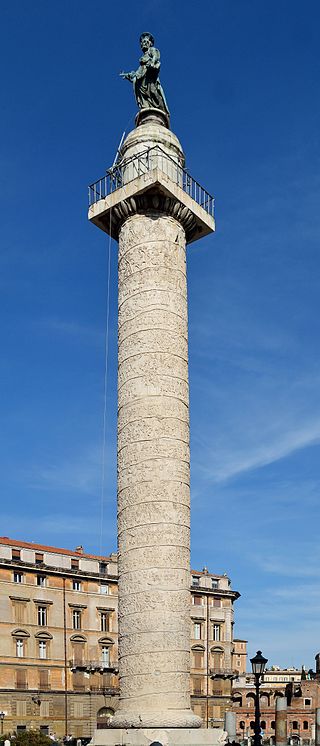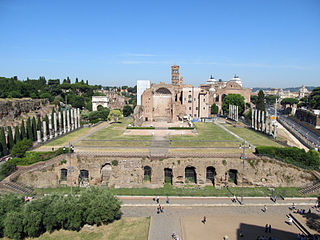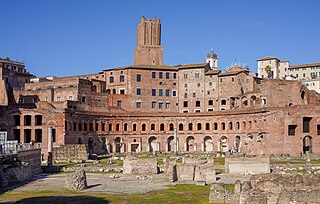Related Research Articles

Ancient Roman architecture adopted the external language of classical ancient Greek architecture for the purposes of the ancient Romans, but was different from Greek buildings, becoming a new architectural style. The two styles are often considered one body of classical architecture. Roman architecture flourished in the Roman Republic and to an even greater extent under the Empire, when the great majority of surviving buildings were constructed. It used new materials, particularly Roman concrete, and newer technologies such as the arch and the dome to make buildings that were typically strong and well engineered. Large numbers remain in some form across the former empire, sometimes complete and still in use today.

The Domus Aurea was a vast landscaped complex built by the Emperor Nero largely on the Oppian Hill in the heart of ancient Rome after the great fire in 64 AD had destroyed a large part of the city.

Trajan's Column is a Roman triumphal column in Rome, Italy, that commemorates Roman emperor Trajan's victory in the Dacian Wars. It was probably constructed under the supervision of the architect Apollodorus of Damascus at the order of the Roman Senate. It is located in Trajan's Forum, north of the Roman Forum. Completed in AD 113, the freestanding column is most famous for its spiral bas relief, which depicts the wars between the Romans and Dacians. Its design has inspired numerous victory columns, both ancient and modern.

A barrel vault, also known as a tunnel vault, wagon vault or wagonhead vault, is an architectural element formed by the extrusion of a single curve along a given distance. The curves are typically circular in shape, lending a semi-cylindrical appearance to the total design. The barrel vault is the simplest form of a vault: effectively a series of arches placed side by side. It is a form of barrel roof.

The Baths of Diocletian were public baths in ancient Rome. Named after emperor Diocletian and built from AD 298 to 306, they were the largest of the imperial baths. The project was originally commissioned by Maximian upon his return to Rome in the autumn of 298 and was continued after his and Diocletian's abdication under Constantius, father of Constantine.

Monte Testaccio or Monte Testaceo, also known as Monte dei Cocci, is an artificial mound in Rome composed almost entirely of testae, fragments of broken ancient Roman pottery, nearly all discarded amphorae dating from the time of the Roman Empire, some of which were labelled with tituli picti. It is one of the largest spoil heaps found anywhere in the ancient world, covering an area of 2 hectares at its base and with a volume of approximately 580,000 cubic metres (760,000 cu yd), containing the remains of an estimated 53 million amphorae. It has a circumference of nearly a kilometre (0.6 mi) and stands 35 metres (115 ft) high, though it was probably considerably higher in ancient times. It stands a short distance away from the east bank of the River Tiber, near the Horrea Galbae where the state-controlled reserve of olive oil was stored in the late 2nd century AD. The mound later had both religious and military significance.

The Temple of Venus and Roma is thought to have been the largest temple in Ancient Rome. Located on the Velian Hill, between the eastern edge of the Forum Romanum and the Colosseum, in Rome, it was dedicated to the goddesses Venus Felix and Roma Aeterna.
Frank Edward Brown was a preeminent Mediterranean archaeologist.
John Haughton D'Arms was the Gerald F. Else Professor of Humanities and professor of classical studies and history at the University of Michigan in Ann Arbor. He also served as president of the American Council of Learned Societies (ACLS). He served ACLS until his death in 2002. He died of brain cancer in New York City.

Trajan's Market is a large complex of ruins in the city of Rome, Italy, located on the Via dei Fori Imperiali, at the opposite end to the Colosseum. The surviving buildings and structures, built as an integral part of Trajan's Forum and nestled against the excavated flank of the Quirinal Hill, present a living model of life in the Roman capital and a glimpse at the restoration in the city, which reveals new treasures and insights about ancient Roman architecture.

The Ludus Magnus, also known as the Great Gladiatorial Training School, was the largest of the gladiatorial schools in Rome. It was built by the emperor Domitian in the late first century C.E., alongside other building projects undertaken by him such as three other gladiatorial schools across the Roman Empire.
Kathleen M. Coleman is an academic and writer who is the James Loeb Professor of the Classics at Harvard University. Her research interests include Latin literature, history and culture in the early Roman Empire, and arena spectacles. Her expertise in the latter area led to her appointment as Chief Academic Consultant for the 2000 film Gladiator.

The Roman architectural revolution, also known as the concrete revolution, is the name sometimes given to the widespread use in Roman architecture of the previously little-used architectural forms of the arch, vault, and dome. For the first time in Europe, possibly in the world, the potential of these elements was fully appreciated and exploited in the construction of a wide range of civil engineering structures, public buildings, and military facilities. Throughout the Roman empire, from Syria to Scotland, engineers erected structures using semicircular arches. The first use of arches was for civic structures, like drains and city gates. Later the arches were utilized for major civic buildings bridges and aqueducts, with the outstanding 1st century AD examples provided by the Colosseum, Pont Du Gard, and the aqueduct of Segovia. The introduction of the ceremonial triumphal arch dates back to Roman republic, although the best examples are from the imperial times.

Domes were a characteristic element of the architecture of Ancient Rome and of its medieval continuation, the Byzantine Empire. They had widespread influence on contemporary and later styles, from Russian and Ottoman architecture to the Italian Renaissance and modern revivals. The domes were customarily hemispherical, although octagonal and segmented shapes are also known, and they developed in form, use, and structure over the centuries. Early examples rested directly on the rotunda walls of round rooms and featured a central oculus for ventilation and light. Pendentives became common in the Byzantine period, provided support for domes over square spaces.
Barbara A. Barletta was a prominent American Classical archaeologist and architectural historian.
Duane W. Roller is an American archaeologist, author, and professor emeritus of classics, Greek and Latin at the Ohio State University.
Janet DeLaine is Emeritus Fellow at Wolfson College, Oxford and a Fellow of the Society of Antiquaries of London. She is a Roman archaeologist whose research has focused on urban environments, with a particular focus on bath complexes, urban development and the building industry in the Roman world.

The Tomb of the Haterii is an Ancient Roman funerary monument, constructed between c. 100 and c. 120 CE along the Via Labicana to the south-east of Rome. It was discovered in 1848 and is particularly noted for the numerous artworks, particularly reliefs, found within.
References
- 1 2 3 4 "Lynne Lancaster - Archaeological Institute of America". www.archaeological.org. Archived from the original on 2019-04-16. Retrieved 2018-06-05.
- 1 2 "Lynne C. Lancaster Is Appointed Andrew W. Mellon Professor-in-Charge of the Humanities". American Academy in Rome. 24 January 2018. Retrieved 5 July 2018.
- ↑ "Lynne C. Lancaster". University of Cincinnati Classics. Retrieved August 3, 2021.
- ↑ "Lynne Lancaster elected as Andrew W. Mellon Professor-in-charge of Humanities at the American Academy in Rome". British School at Rome. Retrieved 5 July 2018.
- ↑ "Lynne Lancaster". www.ohio.edu. Retrieved 2018-06-06.
- ↑ "Thomas H. Carpenter". Ohio University Classics and Religious Studies. Retrieved August 3, 2021.